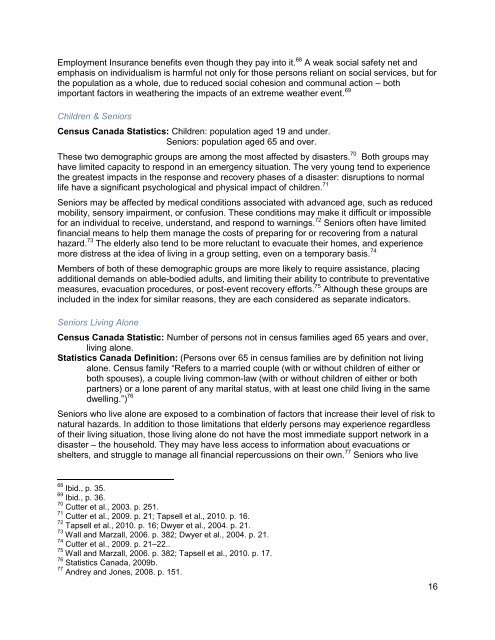Lunenburg Part 2 - Section 5 - Social Vulnerability - August 30.pdf
Lunenburg Part 2 - Section 5 - Social Vulnerability - August 30.pdf
Lunenburg Part 2 - Section 5 - Social Vulnerability - August 30.pdf
You also want an ePaper? Increase the reach of your titles
YUMPU automatically turns print PDFs into web optimized ePapers that Google loves.
Employment Insurance benefits even though they pay into it. 68 A weak social safety net and<br />
emphasis on individualism is harmful not only for those persons reliant on social services, but for<br />
the population as a whole, due to reduced social cohesion and communal action – both<br />
important factors in weathering the impacts of an extreme weather event. 69<br />
Children & Seniors<br />
Census Canada Statistics: Children: population aged 19 and under.<br />
Seniors: population aged 65 and over.<br />
These two demographic groups are among the most affected by disasters. 70 Both groups may<br />
have limited capacity to respond in an emergency situation. The very young tend to experience<br />
the greatest impacts in the response and recovery phases of a disaster: disruptions to normal<br />
life have a significant psychological and physical impact of children. 71<br />
Seniors may be affected by medical conditions associated with advanced age, such as reduced<br />
mobility, sensory impairment, or confusion. These conditions may make it difficult or impossible<br />
for an individual to receive, understand, and respond to warnings. 72 Seniors often have limited<br />
financial means to help them manage the costs of preparing for or recovering from a natural<br />
hazard. 73 The elderly also tend to be more reluctant to evacuate their homes, and experience<br />
more distress at the idea of living in a group setting, even on a temporary basis. 74<br />
Members of both of these demographic groups are more likely to require assistance, placing<br />
additional demands on able-bodied adults, and limiting their ability to contribute to preventative<br />
measures, evacuation procedures, or post-event recovery efforts. 75 Although these groups are<br />
included in the index for similar reasons, they are each considered as separate indicators.<br />
Seniors Living Alone<br />
Census Canada Statistic: Number of persons not in census families aged 65 years and over,<br />
living alone.<br />
Statistics Canada Definition: (Persons over 65 in census families are by definition not living<br />
alone. Census family “Refers to a married couple (with or without children of either or<br />
both spouses), a couple living common-law (with or without children of either or both<br />
partners) or a lone parent of any marital status, with at least one child living in the same<br />
dwelling.”) 76<br />
Seniors who live alone are exposed to a combination of factors that increase their level of risk to<br />
natural hazards. In addition to those limitations that elderly persons may experience regardless<br />
of their living situation, those living alone do not have the most immediate support network in a<br />
disaster – the household. They may have less access to information about evacuations or<br />
shelters, and struggle to manage all financial repercussions on their own. 77 Seniors who live<br />
68 Ibid., p. 35.<br />
69 Ibid., p. 36.<br />
70 Cutter et al., 2003. p. 251.<br />
71 Cutter et al., 2009. p. 21; Tapsell et al., 2010. p. 16.<br />
72 Tapsell et al., 2010. p. 16; Dwyer et al., 2004. p. 21.<br />
73 Wall and Marzall, 2006. p. 382; Dwyer et al., 2004. p. 21.<br />
74 Cutter et al., 2009. p. 21–22..<br />
75 Wall and Marzall, 2006. p. 382; Tapsell et al., 2010. p. 17.<br />
76 Statistics Canada, 2009b.<br />
77 Andrey and Jones, 2008. p. 151.<br />
16














